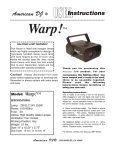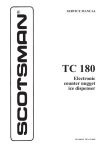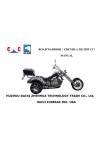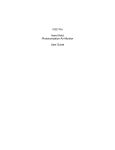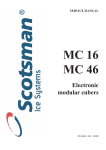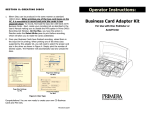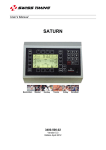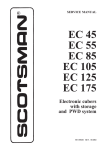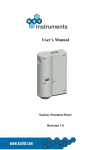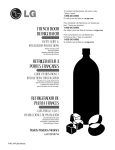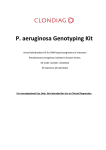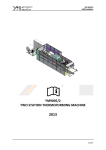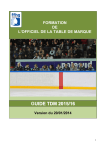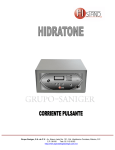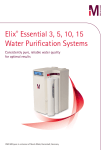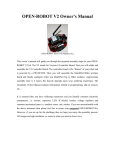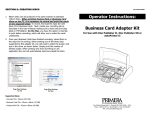Download Energy Usage in Ice Rink Resurfacing
Transcript
Energy Usage in Ice Rink Resurfacing Master thesis report – draft Roni Kaya March 2015 Sammanfattning Ishallar kräver stora mängder energi för sin verksamhet. Undersökningar har visat att en typisk ishall i Sverige använder ca 1 000 MWh per år. Data från de mest effektiva ishallarna har visat att en väl utformad ishall kan nå en energiförbrukning på mindre än 500 MWh per år, vilket ger en stor potential för energisparande åtgärder. En statistisk studie av ett stort antal ishallar i Sverige har visat att kylsystemet har den största andelen av den totala energianvändningen i en ishall, motsvarande 43% i genomsnitt. Kylsystemets energianvändning är kraftigt beroende av olika värmebelastningar på isytan. Tidigare studier har fastställt andelarna i den totala värmebelastningen i ishallar som visat att de värmelaster som uppstår vid avspolning av isytan motsvarar mellan 14-17% av den totala värmelasten. I denna undersökning har spolvattnets volym och temperatur utvärderats med insamlad data genom experimentella mätningar och analyserats vidare med målet att bestämma andelen i totala värmbelastningen och föreslå energisparande åtgärder. Resultaten av studien bygger på data som samlats in i fem olika ishallar i Stockholm, och visar att de flesta fyllningar har en volym mellan 300-500 liter vid en temperatur mellan 30-50°C. Större volymer och högre temperaturer ökar värmebelastningen på isen genom latent och sensibel värme, vilket innebär att mindre volymer och lägre temperaturer minskar värmebelastningen och i sin tur energiförbrukningen. Undersökningen visar också att energiförbrukningen vid laddning av ismaskinerna varierar och pekar åt att förbrukningen ökar med äldre maskiner. Studien visar att genomsnittliga energiförbrukningen för de fem ishallarna vid en avspolning är 18 kWh i en hall med 100% värmeåtervinning (18% till laddning av ismaskin och 82% till kylsystemets kompressor) och 36 kWh utan värmeåtervinning (9% till laddning av ismaskin, 49% uppvärmning av spolvatten och 42% till kylsystemets kompressor), vilket indikerar en besparing i energiförbrukning genom integrerat värmeåtervinningssystem. Andelen av den totala värmelasten från mätningar visar att i genomsnitt 11% av totala värmebelastningen uppstår på grund av avspolningar. Abstract Ice rink operations require significant amounts of energy. It has been concluded that a typical single sheet ice rink in Sweden uses around 1 000 MWh per year. Data from the most efficient ice rinks has shown that a well-designed ice rink could reach an energy usage of less than 500 MWh per year, which leaves a great potential for energy saving actions. A statistical study of more a large number ice rinks in Sweden has shown that the refrigeration system has the largest share of the total energy consumption in an ice rink, corresponding to 43% in average. The energy consumption of the refrigeration system is depending on various heat loads on the ice surface. Previous studies has determined the shares of the total heat load in ice rinks, concluding that one of the four largest heat loads in an ice rink comes from the ice resurfacing, corresponding to 14-17%. Floodwater volume and temperature has been evaluated by collecting data through experimental measurements and further analysed with the aim to find energy saving actions. The results of the study are based on data collected in five different ice rinks in Stockholm, Sweden and shows that most fillings of resurfacing machines has a volume between 300-500 litres at a temperature between 30-50°C. Larger volumes and higher temperatures increase the heat load on the ice surface through latent and sensible heat, which means that smaller volumes and lower temperatures decrease the energy consumption. It has also been concluded that older resurfacing machines are larger energy consumers compared with newer models. The study shows that the energy consumption for an average resurfacing process 18 kWh with 100% heat recovery (18% from charging and 82% compressor electricity) and 36 kWh without heat recovery (9% from charging, 49% heating electricity and 42% compressor electricity), which indicates a decrease in energy consumption in ice rinks with heat recovery. Resurfacing share of total heat loads from measurements show that in average 11% of the heat load is occurring by resurfacing. ACKNOWLEDGEMENTS First of all, I would like to express my gratitude to my main supervisor Jörgen Rogstam (Energi & Kylanalys AB) for giving me this assignment, constant support and sharing both office and his huge knowledge through comments and discussions. You have been dedicated in my thesis from the start through this whole period. Special thanks to my supervisor at KTH, Samer Sawalha, for introducing me to refrigeration systems and giving me the inspiration and support to write this thesis. I want to thank all the people that have been involved; the janitors at the visited ice rinks for their own curiosity in the results and for never getting tired of my visits, Chadi Beaini for helping me with the first setup and teaching me how to use a flow meter, Kenneth Weber at ETM Kylteknik AB for borrowed equipment and instructions on how to use data loggers. I can’t express my gratitude towards my dear parents Afif and Imran, my brother Felat, sisters Zozan and Newroz and lots of friends for their love and support through all my years at KTH. It would have been much more difficult without you! Roni Kaya Stockholm, February 4th, 2015 TABLE OF CONTENTS ACKNOWLEDGEMENTS ........................................................................................................................ 5 TABLE OF CONTENTS ........................................................................................................................... 7 NOMENCLATURE .................................................................................................................................... 9 INDEX OF FIGURES ............................................................................................................................. 11 INDEX OF TABLES ............................................................................................................................... 13 1. INTRODUCTION .............................................................................................................................. 15 1.1 Objectives................................................................................................................................................... 15 1.2 Methodology ............................................................................................................................................. 16 1.3 Scope and limitations ............................................................................................................................ 16 2. ICE RINK SYSTEMS ......................................................................................................................... 17 2.1 Energy demands ...................................................................................................................................... 17 2.1.1 Heating and ventilation................................................................................................................................. 17 2.1.2 Dehumidification ............................................................................................................................................. 19 2.1.3 Lighting ................................................................................................................................................................ 20 2.2 Heat loads .................................................................................................................................................. 21 2.2.1 Conductive loads.............................................................................................................................................. 22 2.2.2 Convection and condensation loads ........................................................................................................ 22 2.2.3 Radiation ............................................................................................................................................................. 22 2.3 Refrigeration system.......................................................................................................................... 24 2.3.1 Indirect and direct systems ......................................................................................................................... 25 2.3.2 Refrigerants ....................................................................................................................................................... 27 2.3.3 Secondary refrigerants.................................................................................................................................. 28 2.3.4 Coolants and dry cooler ................................................................................................................................ 29 2.3.5 Compressors ...................................................................................................................................................... 30 3. ICE MAINTENANCE ......................................................................................................................... 32 3.2 Ice resurfacing.......................................................................................................................................... 32 3.2 Water and Ice Quality ............................................................................................................................ 34 3.2.1 Water heating.................................................................................................................................................... 34 3.2.2 Deionization....................................................................................................................................................... 35 3.2.3 Vortex treatment ............................................................................................................................................. 36 4. EXPERIMENTS ................................................................................................................................. 37 4.1 Temperature and Water Volume Measurements ........................................................................ 37 4.1.1 Measuring methods ........................................................................................................................................ 37 4.1.2 Equipment .......................................................................................................................................................... 38 4.1.3 Methods description ...................................................................................................................................... 39 4.1.4 Results .................................................................................................................................................................. 41 4.2 Energy Consumption of Resurfacing Machine .............................................................................. 43 4.2.1 Equipment .......................................................................................................................................................... 43 4.2.2 Measuring methods ........................................................................................................................................ 44 4.2.3 Results .................................................................................................................................................................. 45 4.3 Heat loads and Energy Consumption from Resurfacing ........................................................... 45 4.3.1 ClimaCheck method ........................................................................................................................................ 46 4.3.2 Calculating methods ....................................................................................................................................... 46 4.3.3 Results .................................................................................................................................................................. 48 4.4 Ice thickness measurements............................................................................................................... 51 4.4.1 Equipment .......................................................................................................................................................... 52 4.4.2 Methods description ...................................................................................................................................... 52 4.4.3 Results .................................................................................................................................................................. 54 4.5 Freezing time and temperature drop of floodwater .................................................................. 55 4.5.1 Equipment .......................................................................................................................................................... 55 4.5.2 Method ................................................................................................................................................................. 55 4.5.3 Results .................................................................................................................................................................. 56 5. DISCUSSION AND CONCLUSIONS ............................................................................................... 60 5.1 Temperature and Water Volume Measurements .................................................................... 60 5.1.2 Energy Consumption of Resurfacing Machine .................................................................................... 60 5.1.3 Heat loads and Energy Consumption from Resurfacing ................................................................. 61 5.1.4 Ice thickness measurements....................................................................................................................... 61 5.1.5 Freezing time and temperature drop of floodwater ......................................................................... 62 5.2 Conclusions ............................................................................................................................................... 63 6. RECOMMENDATIONS AND FUTURE WORK ........................................................................... 66 6.1 Recommendations .................................................................................................................................. 66 6.2 Future work .............................................................................................................................................. 66 7. REFERENCES .................................................................................................................................... 67 NOMENCLATURE Symbol Description 𝑚̇ Mass flow (kg/s) t Temperature/Absolute temperature (°C/K) 𝑄̇ Heating/Cooling capacity (W) 𝛼𝑐 Convective heat transfer coefficient A Area (m2) 𝑣 Velocity (m/s) 𝐾 Mass heat transfer coefficient 𝑋 Mole fraction 𝑓𝑐𝑖 Gray body configuration factor for radiation from ceiling to ice surface 𝜎 Stefan-Boltzmann constant 𝜀𝑐𝑒𝑖𝑙𝑖𝑛𝑔 Emissivity factor for normal ceiling constructions 𝐹𝑐𝑖 Angle factor 𝐸̇𝑘 Compressor work (W) 𝐸̇𝑒𝑙 Compressor electrical input (W) ℎ Enthalpy (J) 𝜂𝑒𝑙𝑚 Electrical motor efficiency compressor 𝑉 Volume (m3) 𝐶𝑝 Specific heat capacity (kJ/KgK) ΔH𝑤𝑎𝑡𝑒𝑟→𝑖𝑐𝑒 Heat fusion water to ice (kJ/Kg) 𝑅𝐻 Relative humidity (%) 𝐴𝐻 Absolute humidity (gH2O/kgAir) 𝜌 Density (kg/m3) 𝑀 Molecular weight (g/mol) 𝑃 Pressure (Pa) 𝑛 Moles 𝑅 Universal gas constant 𝑃𝑠𝑎𝑡 Saturation pressure for water vapours DHW Domestic Hot Water HW Hot Water MW Mixed Water CW Cold Water COP Coefficient of Performance INDEX OF FIGURES Figure 1.Typical shares of energy consumers in ice rinks (Rogstam, 2010) ................................ 17 Figure 2.Energy systems in ice rinks (Energi- & Kylanalys, 2014) ............................................. 17 Figure 3. Configurations of heat rejection and heat recovery from a refrigeration system (Sawalha, 2010) ..................................................................................................................... 18 Figure 4. Heat sources in ice rinks (Stopsladd, 2010) ................................................................... 19 Figure 5. Principles of water vapour condensation ....................................................................... 19 Figure 6. Desiccant humidification system ............................................................................... 20 Figure 7. Desiccant humidification system connected to the ventilation system in a Swedish ice rink ........................................................................................................................................ 20 Figure 8. Shares of the total heat load in a Swedish ice rink (Abdi et al., 2012) .......................... 21 Figure 9. Comparison between high and low emissivity ceilings ................................................. 23 Figure 10. Angle factor for radiation between parallel rectangles ................................................ 24 Figure 11. Shares of energy usage in refrigeration systems (Rogstam, 2010) .............................. 24 Figure 12.Log p-h diagram with marked area of possible heat recovery ...................................... 25 Figure 13. Direct (left) and indirect (right) refrigeration systems in ice rinks .............................. 26 Figure 14. Distribution of different types of systems in Swedish ice rinks 2010 (Rogstam, 2010) ............................................................................................................................................... 26 Figure 15. System layout for an indirect refrigeration system integrated with heat recovery (IIHF, 2010)...................................................................................................................................... 27 Figure 16. The use of various refrigerants in Swedish rinks (Rogstam, 2010) ............................. 28 Figure 17. Dry cooler in a Swedish ice rink .................................................................................. 30 Figure 18. Piston compressor ........................................................................................................ 30 Figure 19. Screw compressor ........................................................................................................ 30 Figure 20.Sketch of resurfacing machine shaving the ice surface (ORFA, 1991) ........................ 32 Figure 21.Ice depth checkpoints.................................................................................................... 32 Figure 22. Common areas of thin ice and ice build-up in ice rinks (ORFA, 1991) ...................... 33 Figure 23. A typical resurfacing machine in detail (DailyMail, 2013) ......................................... 33 Figure 24. Resurfacing machine water tank inlet marked with "Only hot water" ........................ 34 Figure 25. Solubility of air in water for different temperatures .................................................... 35 Figure 26. Reversed osmosis flow chart (deionization system) (http://fc00.deviantart.net/fs71/i/2010/167/9/d/Reverse_Osmosis_Flow_Chart_by_BrentPoy nter.jpg) ................................................................................................................................. 35 Figure 27. Sketch figure over vortex treatment generation ........................................................... 36 Figure 28. Water mixed before valve (left) and water mixed in valve (right) .............................. 37 Figure 29. Water system with water mixed before valve in one of the examined ice rinks ......... 39 Figure 30. Logging interval set in HOBOware software .............................................................. 39 Figure 31. Thermocouple attached to water pipe .......................................................................... 40 Figure 32.Flow meter sensors attached to water pipe ................................................................... 40 Figure 33.Total numbers of fillings and volumes for all ice rinks ................................................ 42 Figure 34.Average filling temperature and volume in ice rink 4 during one day ......................... 42 Figure 35.Total number of fillings and temperature for all ice rinks ............................................ 43 Figure 36. Electricity meter with 32 A connectors ....................................................................... 44 Figure 37. Method for measuring electricity consumption of resurfacing machine ..................... 44 Figure 38. Energy balance over compressor ................................................................................. 46 Figure 39.Humidity in ice rink 2 during one day in September 2014 ........................................... 47 Figure 40.Humidity in ice rink 2 during one day in October 2014 ............................................... 47 Figure 41.Heat loads depending on volume and temperature ....................................................... 49 Figure 42.Energy shares from one resurfacing without heat recovery ......................................... 50 Figure 43. Energy shares from one resurfacing with heat recovery.............................................. 50 Figure 44. Theory of how ultrasonic signals could be used to determine air content in ice ......... 51 Figure 45. Menu for adjusting velocity in measured material ...................................................... 52 Figure 46. Speed of sound in pure ice at temperatures between 0 and -20°C (Vogt et. al, 2008) 52 Figure 47. Ice in isolated jar .......................................................................................................... 53 Figure 48. Measuring points at examined ice rink ........................................................................ 53 Figure 49. Comparison between theory and reality of how ultrasonic thickness meter operated . 55 Figure 50. Temperature logger attached to resurfacing machine water outlet .............................. 55 Figure 51. Temperature logger attached to resurfacing machine water inlet ................................ 56 Figure 52. Temperature logger attached to ice surface ................................................................. 56 Figure 53. Inlet and outlet temperatures measured during resurfacing occasions in ice rink A ... 57 Figure 54. Inlet and outlet temperatures measured during resurfacing occasions in ice rink B ... 57 Figure 55. Recovering time for ice surface temperature after resurfacing process....................... 58 Figure 56. Resurfacing machine outlet ......................................................................................... 59 Figure 57. Temperature layers during resurfacing process ........................................................... 59 Figure 58.Floodwater temperatures conducted through questionnaire survey (Stoppsladd, 2010) ............................................................................................................................................... 60 Figure 59.Total number of fillings and temperature for all ice rinks ............................................ 60 Figure 60. Comparison of energy shares without heat recovery between largest and least energy consuming machine ............................................................................................................... 61 Figure 61. IceTec8 measurement tool for ice thickness ................................................................ 62 Figure 62. Temperature drop in tank during night ........................................................................ 63 INDEX OF TABLES Table 1. Lighting options for ice rinks (IIHF, 2010) .................................................................... 21 Table 2.Criteria for refrigerants (Graneryd et al. 2011) ................................................................ 27 Table 3. Advantages and drawbacks of secondary refrigerants used for ice rink application (Mazzotti, 2014) .................................................................................................................... 29 Table 4. List of solids dissolved in raw water supplies (ORFA,1991) ......................................... 36 Table 5. List of different types of deionization systems and energy consumption (Kinetico, 2015) (Seleko, 2015) ....................................................................................................................... 36 Table 6. Results from temperature and volume measurements .................................................... 41 Table 7. Resurfacing machines energy consumptions for the five different ice rinks .................. 45 Table 8.Average energy consumption for one resurfacing occasion ............................................ 49 Table 9.Average energy consumption for resurfacing during one season .................................... 49 Table 10.Resurfacing share of total heat loads from measurements ............................................. 50 Table 11.Heat loads caused by humidity difference during one resurfacing occasion ................. 51 Table 12. Validation of measuring equipment .............................................................................. 53 Table 13. Ice depth measurements in ice rink ............................................................................... 54 Table 14. Waste in energy consumption for heating of resurfacing water caused by temp. drop 58 1. INTRODUCTION This chapter describes the background of how the general ice rink for various types of activities has developed a need of energy efficient solutions for a sustainable future. It also contains the objectives, methods and limitations in this thesis. As the request of artificial ice surfaces has grown in pace with climate change and commercial availability requirements, the use of ice surfaces has changed through history from being a way to travel to become a worldwide industry in sports as ice hockey, curling, figure skating, speed skating, recreational skating etc. (ASHRAE, 2014). Meanwhile, an increased awareness regarding the environment, energy consumption and expenses has led to technical developments and efficiency improvements in ice rinks and refrigeration systems. The development of sports on ice has also led to increased demands regarding the ice quality depending on the activity that is taking place. Ice rink operations require significant amounts of energy. It has been concluded that a typical single sheet ice rink in Sweden uses around 1 000 MWh per year. Data from the most efficient ice rinks has shown that a well-designed ice rink could reach an energy usage of less than 500 MWh per year (Stoppsladd, 2010), which leaves a great potential for energy saving actions. A statistical study of more than one hundred ice rinks in Sweden has shown that the refrigeration system has the largest share of the total energy consumption in an ice rink, corresponding to 43% in average (Rogstam, 2010). There are currently over 360 indoor and 140 outdoor ice rinks in Sweden, with a continuously increasing rate. Ignoring investigations regarding energy efficient solutions will thus result in a steady increase of energy consumption (Rogstam, 2010). The energy consumption of the refrigeration system is totally dependent on various heat loads on the ice surface (ASHRAE, 2014). A closer look on where these loads originates from gives an idea of where efficiency measures can help to reduce the energy consumption of the ice rink’s refrigeration system. Previous studies has determined the shares of the total heat load in ice rinks, concluding that one of the four largest heat loads in an ice rink (14-17%) comes from ice resurfacing (Rogstam, 2010). Despite the large amount of heat charged by the ice resurfacing process, it is currently uncommon with measurement equipment on board on ice resurfacing machines for monitoring temperature and used water volume (Olympia, 2014) (Zamboni, 2014). This indicates an obvious need for evaluating the volume and temperature of the water, as well as finding a practical way to measure and display these parameters by e.g. retrofitting current machines, which will be the aim of this work. 1.1 Objectives The objective of this study is to evaluate the resurfacing floodwater amount and temperature used in ice rinks with the goal to determine if reduction of water and thus cooling energy is possible while maintaining similar ice quality. The aim to reduce used energy by feeding the evaluated information back to operators will be followed by these steps: Maintain a fundamental understanding regarding heat loads, refrigeration systems and resurfacing machines in ice rinks Evaluate measurements regarding heat loads from resurfacing machines, amount of water used, water temperature, electrical energy and temperature drop rate of floodwater in resurfacing machines Define “good quality ice” and examine the freezing time depending on actual amount and temperature of the floodwater Evaluation of how temperature and floodwater volume affects the refrigeration system and ice quality Estimate the saving potential with optimized use of floodwater Evaluate the potential impact of water treatment Find a suitable solution for the measurement of water volume and temperature with the ambition to install a monitor on ice resurfacing machines in the future 1.2 Methodology The basic understanding of how ice rink systems work is a vital first step towards the goal of introducing energy efficient measures. A large-scale literature review of how the system is affected by heat loads, how the refrigeration systems are designed and how resurfacing machines work today is made. The literature review also includes how to define “good quality ice” to be able to determine the results of ice resurfacing experiments. The experiments will be made on five different ice rinks in the south part of Stockholm, Sweden, where temperature measurements, water volume and energy consumption of the resurfacing machines will be considered. The number of resurfacing processes will be confirmed by thermocouples, ultrasonic flow meter and an online tool connected to the ice rinks named ClimaCheck, where a real time analysis of the ice rink parameters is received. 1.3 Scope and limitations The experiments in this thesis have been made in five different typical indoor ice rinks of about 1800 m2, located south of Stockholm, where hockey and other activities are practiced. The ice rinks are categorized as training facilities without requirements regarding audience seats, lighting, and seats for media or TV-cameras etc. The facilities are most often used as training area for school activities, for the public and lower division teams. Making good ice is based on craftsmanship, which puts some limitations as to the icemakers want to do. 2. ICE RINK SYSTEMS This chapter will briefly explain the different parts of the energy systems in an ice rink and some energy efficient measures that can be made to decrease the energy consumption for these systems. 2.1 Energy demands As there are various demands in an ice rink, identified in figure 2, different energy systems require different amounts of energy. Figure 1 shows an overview of the different energy users in ice rinks, concluding that refrigeration (43%), heating (26%), lighting (10%), ventilation fans (9%) and dehumidification (6%) are among the largest energy consumers. Figure 1.Typical shares of energy consumers in ice rinks (Rogstam, 2010) Figure 2.Energy systems in ice rinks (Energi- & Kylanalys, 2014) 2.1.1 Heating and ventilation The proportion of energy for heating is slightly more than 25% in an average ice rink, which puts it as the second-largest energy user. It provides the required heat for needs such as: Space Heating – The warm, heated zones as spectator stands, locker rooms, office spaces Ventilation – The heat needed for the ventilation system. Delivers fresh air to occupants and provides the standard air change rate to avoid pollutant, smell, fog and biological disease sources concentration. For public areas, air change required in the closed spaces including restaurant, offices, drying rooms, medical rooms, locker rooms (for players, coaches, referees and linesmen) and toilets/showers should be considered (IIHF, 2010) DHW – Domestic hot water used in the building for purposes as sanitation, personal hygiene Resurfacing Water – Heated water (usually 30-40°C in Sweden) used for filling of resurfacing machines Floor/Subsoil Heating – Pipes placed in the ground under the ice surface to prevent it from freezing A great share of the heating demand, up to 100% (ASHRAE, 2014), can be covered by sensible heat recovery by using the rejected heat from the refrigeration system through the condenser or de-superheater, as the refrigeration system can be used both on the evaporator side for cooling and condenser side as a heat pump. Some examples of the integrated method are shown in figure 3. The left layout is called floating condensing, a refrigeration system without heat recovery, where the refrigerant heat is rejected to atmosphere as the condensation pressure follows the ambient temperature. This case requires the heating demand to be covered by a separate heat source as district heating, heat pump, electrical heating etc. The middle layout is a heat recovery system with a de-superheater. This system is suitable when the discharge temperature is relatively high, which is common for refrigeration systems using NH3 or CO2. The regulating valve placed after the condenser/gas cooler can adjust the discharge pressure hence the heating capacity. The layout to the right is a fixed-head pressure heat recovery system. The discharge pressure is adjusted according to the HVAC system demand. A coolant transfers the heat from the condenser to the HVAC system. The temperature is comparatively low (~30°C) compared to the discharge temperature (~100°C), which limits the usage. (Sawalha, 2010) Figure 3. Configurations of heat rejection and heat recovery from a refrigeration system (Sawalha, 2010) Figure 4 shows how the shares of the heat sources are divided in Swedish ice rinks and leaves a great potential for energy savings with an integrated system instead of electrical and district heating, commonly used for additional heating. There are probably a few plants that are heated by oil, gas or pellets but they are unusual and therefore overlooked. Figure 4. Heat sources in ice rinks (Stoppsladd, 2010) 2.1.2 Dehumidification The climate in an ice rink is important for the building and its visitor's well being. A humid environment thrive mould that can affect the working environment for employees and visitors, but also cause corrosion of metal and wooden structures of the building. The climate has a major impact on ice quality and load on the ice surface. The moisture in the surrounding air is also defrosting the ice surface and makes it porous, which in turn degrades the ice quality. A controlled dehumidified air above the ice provides a solid foundation for good ice quality and a lower heat load on the ice, resulting in a reduction of energy consumption for the refrigeration system. There are currently two common ways of dehumidifying the air. One is by water vapour condensation where the principle is to cool the humid air below its dew point. The humid air is can be cooled through the evaporator or cold brine to create a cooled surface where the humidity of the air condenses and separate, which process can be seen in figure 5. This method needs a large volume of air to flow through and is also heated through the condenser before it is sent back to the ice rink. Figure 5. Principles of water vapour condensation Figure 6. Desiccant humidification system The most common method for dehumidifying the air is though the desiccant humidification system shown in figure 6. The figure shows the “desiccant wheel” that rotates, which consists of a water-absorbing material, usually silica gel, which absorbs the moist of the humid air passing through. The dry air is then supplied back to ventilation system and distributed back to the ice rink. The absorbed moisture is simultaneously released as the wheel is regenerated in another part by heated air and driven out as wet air. Electrical heaters are often used for regenerating the desiccant wheel, but can partly be heated by suction gas from the refrigeration system to decrease the energy consumption of the humidifier. Figure 7 illustrates a typical desiccant humidification system installed in a Swedish ice rink. (Rogstam, 2010) Figure 7. Desiccant humidification system connected to the ventilation system in a Swedish ice rink 2.1.3 Lighting There are different requirements for brightness, 200-1 000 lux. The type of ice rink determine installation requirements both in terms of the level at which the sport will be exercised in the ice rink and the performance of many energy-related systems need to have. Table 1. Lighting options for ice rinks (IIHF, 2010) Type Compact fluorescent lamps Standard fluorescent lamps Metal halide lamps High pressure sodium lamps Induction lamps Halogen lamps Applicability Power range [W] Lifetime [h] Comment General lighting 5-55 8 000 - 12 000 Good energy efficiency General lighting Rink lighting 30-80 20 000 Good energy efficiency Rink lighting 35-2000 6 000 - 20 000 Good for rink lighting Rink lighting 50 - 400 14 000 - 24 000 Poor color rendering Rink lighting 55 - 165 60 000 Special lighting 20 - 20 000 2 000 - 4 000 Long life, expensive Excellent color rendering, good dimming possibilities To meet these requirements there are different types of installations like metal halide and various types of fluorescent tubes. For the lighting, which is the third largest energy consumer, it is clear that the newer systems with modern lights and good control system uses significantly less energy than older models. Since lighting sources must be replaced at regular intervals, such situation is a good occasion to upgrade the whole lighting system instead of just buying new fluorescent lamps. Over half of the installed capacity in ice rinks is of the older model. If all these older fixtures where replaced, it would provide savings of an average of 23.6 MWh per year and rink. Different types of fluorescent lighting is the most common form of Swedish ice rinks. 75% of installed power is divided between fluorescent T5 and T8 with or without electronic ballast. Of these, the majority is, 53%, fluorescent tubes with conventional ballast. (Rogstam, 2010) 2.2 Heat loads An important aspect of the refrigeration system is to understand where the heat load is coming from, which in turn determines the required cooling demand. The amounts of energy usage decrease as these heat loads are reduced. To exemplify the heat load shares, figure 8 shows a comparison of shares of heat loads in a Swedish ice rink made in a previous study. 17% Convection Lighting 36% 5% Ground 3% Skaters Radiation 13% 1% Diffusion pump 4% 5% Brine header Ice resurfacing 16% Figure 8. Shares of the total heat load in a Swedish ice rink (Abdi et al., 2012) 2.2.1 Conductive loads Brine pump, activities on ice, ground heat, header pipe and resurfacing water together form the conductive loads affecting the refrigeration system. (ASHRAE, 2014) A frequency controlled brine pump, regulated by the heat load on the ice is one way to decrease its conductive load on the system. In other words, the pump is not working under a constant speed but slower the smaller load and faster as the load increase. A proper insulation of the substrate reduces the heat flux from the ground heat significantly. If ground frost protection is installed, insulation between it and the brine circuit is very important to avoid a thermal short circuit between the systems, where the heat goes from frost protection directly to the brine which in turn results in a larger load on the refrigeration system. (Rogstam, 2010) Ice resurfacing is a requirement to maintain the ice surface in a good condition. Ice resurfacing machines shaves the ice surface and pours down a layer of water on the ice. The volume and temperature of the water is directly affecting the heat load on the ice as sensible and latent heat and it varies between ice rinks. (ORFA,1991) The ice-resurfacing load is examined separately as one of the cornerstones in this thesis and can be followed in chapter 4. 2.2.2 Convection and condensation loads Convective loads are affected by air temperature, water content and air velocity over the ice. Water vapour in the humid air rejects its heat to the ice and condenses on the surface. Humidifying the air is necessary to avoid condensation and keep the relative humidity low. A proper installation of vents with a lower air velocity over the ice is also a solution to decrease the load as the convective heat transfer decreases. The temperature difference between the ice temperature and moving air above the ice is the driving force for convection and can be calculated by following equation: 𝑄̇𝑐𝑜𝑛𝑣𝑒𝑐𝑡𝑖𝑜𝑛 = 𝛼𝑐 𝐴𝑖𝑐𝑒 (𝑡𝑎𝑖𝑟 − 𝑡𝑖𝑐𝑒 ) (2.1) Where 𝛼𝑐 is the convective heat transfer coefficient, which is dependent of the air velocity over the ice as following: 𝛼𝑐 = 3.41 + 3.55𝑣𝑎𝑖𝑟 (2.2) The driving force for condensation is the difference between the partial pressure of water vapour in the air close to ice surface and the saturation pressure of water on ice surface. Following equation is suitable for ice rink floors (ASHRAE, 2014): 𝑄̇𝑑𝑖𝑓𝑓𝑢𝑠𝑖𝑜𝑛 = [𝐾(𝑋𝑎𝑖𝑟 − 𝑋𝑖𝑐𝑒 )(2 852𝑘𝐽/𝑘𝑔)(18𝑘𝑔/𝑚𝑜𝑙𝑒) ] (2.3) Where: K = mass heat transfer coefficient ≈ 0.23 g/ (s∙m2) Xair = mole fraction of water in air, kg mole/kg mole ≈ 6.6∙10-3 Xice = mole fraction of water in saturated ice, kg mole/kg mole ≈ 3.6∙10-3 2.2.3 Radiation The ceiling and lighting are the two major sources of radiation in an ice rink as it is designed with a large flat ice surface during a relatively warmer roof. The roof and ice emissivity is very important for the radiation exchange and can be reduced considerably e.g. with canvas or low emissivity sheets as aluminium foils or aluminium based clothes and paints covering the roof. The lighting has a major impact where as much as 60% of rated output can be radiation that is absorbed by the ice directly. (Rogstam, 2010) A simple way to reduce this heat load is to control the light intensity according to the demand since it is not necessary to have lighting with full intensity all the working hours of the ice rink. It could instead keep a lower intensity during public openings and training sessions as it increase in intensity during competitive games with spectators. As seen in figure 9, a low emissivity ceiling that reduces the radiation load on the ice surface, allows the refrigeration system to work with a higher brine temperature and thus work with lower energy consumption. (ASHRAE, 2014) Figure 9. Comparison between high and low emissivity ceilings Stefan-Boltzmann equation can be applied to calculate the radiation from the ceiling as following: 𝑄̇𝑅𝑎𝑑𝑎𝑖𝑡𝑖𝑜𝑛 = 𝐴𝑐𝑒𝑖𝑙𝑖𝑛𝑔 𝑓𝑐𝑖 𝜎(𝑡𝑐𝑒𝑖𝑙𝑖𝑛𝑔 4 − 𝑡𝐼𝑐𝑒 4 ) (2.4) Where: A = area (m2) t = absolute temperature (K) σ = 5.67x10-8 W/(m2K4) (Stefan-Boltzmann constant) ƒci = gray body configuration factor for radiation from ceiling to ice surface: 1 𝑓𝑐𝑖 = [𝐹 + (𝜀 𝑐𝑖 1 𝑐𝑒𝑖𝑙𝑖𝑛𝑔 − 1) + 𝐴𝑐𝑒𝑖𝑙𝑖𝑛𝑔 𝐴𝑖𝑐𝑒 (𝜀 1 𝑖𝑐𝑒 − 1)] −1 (2.5) Where ɛ is the emissivity factor and for normal ceiling constructions and ice structure ranges between 0.8 and 0.95. Special aluminium paint can lower the emissivity to between 0.5 and 0.2 and polished metals as aluminium foil has an emissivity factor around 0.05. Low-emissivity ceilings also decrease condensation problems as it is cooled very little by radiant loss and its temperature remains above the dew point of the rink air (ASHRAE, 2014). Fci is the angle factor and depends on the geometric properties of the ceiling surface, ice surface and the ice rink height. Angle factor for radiation between parallel rectangles is show in figure 10. Figure 10. Angle factor for radiation between parallel rectangles 2.3 Refrigeration system The refrigeration system can be referred as the cornerstone of the ice rink since it provides the rink with the main purpose of an ice rink – the ice surface. It includes electricity for compressors, coolant pumps, brine pumps and dry cooler fans. Figure 11 illustrates the shares of energy usage in refrigeration systems, indicating the compressors as the by far largest consumer. Figure 11. Shares of energy usage in refrigeration systems (Rogstam, 2010) The cooling capacity in a vapour compression cycle unit depends on the mass flow and enthalpy difference of the refrigerant as it passes through the evaporator by following equation: 𝑄̇2 = 𝑚̇ ∗ (ℎ2𝑘 − ℎ𝑠 ) (2.6) All of the supplied electrical power to the compressors is not converted to use work as some is rejected as heat to the ambient and is defined as 𝑄̇𝑙𝑜𝑠𝑠𝑒𝑠 and each compressor has its own specific electrical motor efficiency, 𝜂𝑒𝑙𝑚 . A correlation for power consumption is expressed in equation 2.7. The mass flow rate is obtained in eq. 2.9 by combining eq. 2.7 and 2.8. 𝐸̇𝑘 = 𝐸̇𝑒𝑙 ∗ 𝜂𝑒𝑙𝑚 − 𝑄̇𝑙𝑜𝑠𝑠𝑒𝑠 (2.7) 𝐸̇𝑘 = 𝑚̇ ∗ (ℎ1𝑘 − ℎ2𝑘 ) (2.8) 𝑚̇ = 𝐸̇𝑒𝑙 ∗𝜂𝑒𝑙𝑚 −𝑄̇𝑙𝑜𝑠𝑠𝑒𝑠 (ℎ1𝑘 −ℎ2𝑘 ) (2.9) The COP (Coefficient Of Performance) of the unit can be calculated with the known cooling and heating capacity and the electrical power input: 𝐶𝑂𝑃1 = 𝑄̇1 𝐸̇𝐸𝑙 𝑄̇ 𝐶𝑂𝑃2 = 𝐸̇ 2 𝐸𝑙 (2.10) (2.11) where COP1 is for heating and COP2 for cooling. The ratio between COP1 and COP2 is: 𝐶𝑂𝑃1 = 𝐶𝑂𝑃2 + 1 (2.12) Figure 12 shows an example of how the different enthalpies for cooling and heating capacity and compressor work can be spotted in a log p-h diagram: Figure 12.Log p-h diagram with marked area of possible heat recovery 2.3.1 Indirect and direct systems The refrigeration systems in ice rinks are usually compact units with compressor, condenser and evaporator in the machine room connected to a heat exchanger (indirect system) or a spread system with the ice pad as evaporator and a condenser cooled by ambient air (direct system). The direct system uses a flooded evaporator, which is a type of tank, where refrigerant is available in both gas and liquid form. The liquid is pumped from the lower part of the tank into the pipes under the rink and absorbs heat. The partially vaporized and is then returned to the same tank as both gas and liquid. In the upper part of the tank is sucked gaseous refrigerant out of the compressor and compressed. The direct systems have a very large amount of refrigerant that can be released if there is leakage. Both the risk of leakage among people in ice rinks and a willingness to reduce refrigerant fillings have made use of this type of solution decreased dramatically in recent years. Figure 13. Direct (left) and indirect (right) refrigeration systems in ice rinks Indirect cooling systems are built in most cases as a more compact system with less leakage as the amount of refrigerant is reduced considerably. It consists of three components; a coolant circuit for cooling the condenser heat through the dry cooler, a brine circuit to remove heat from the ice and a refrigerant circuit in the cooling unit. The different parts in direct and indirect systems are described in figure 13 with the cooling unit/machine room inside the dashed line. There are also some cases where one side of the system is of direct type. These are called partially indirect systems. The current distribution of different types of systems is shown in figure 14. Figure 14. Distribution of different types of systems in Swedish ice rinks 2010 (Rogstam, 2010) The refrigeration unit cools the brine in the evaporator and the brine is sent to the embedded cooling pipes below the ice pad. The refrigeration system typically consists of a vapour compression cycle driven by electricity as the primary cycle. About 85% of the Sweden ice rinks use Ammonia as the refrigerant while the remaining use R404A, R134a or other HFC refrigerants (Makhnatch, 2010). Figure 15 shows the layout of a typical ice rink with indirect system and heat recovery. Figure 15. System layout for an indirect refrigeration system integrated with heat recovery (IIHF, 2010) 2.3.2 Refrigerants A working fluid in a vapour compression refrigeration system has to satisfy a number of requirements that can be divided into two groups (Graneryd et al. 2011): Safety: Not cause any risk of injuries, panic, fire or property damage in case of leakage Fluid properties: Chemical, physical and thermo dynamical properties of the refrigerant have to be suitable for the system and the working condition at lowest cost Table 2.Criteria for refrigerants (Graneryd et al. 2011) Chemical Health, safety and environmental Thermal Miscellaneous Stable and inert Non-toxic Non-flammable Friendly for the atmosphere Critical point and boiling point temperatures appropriate for the application Low vapour heat capacity Low viscosity High thermal conductivity Satisfactory oil solubility/miscibility High dielectric strength of vapour Low freezing point Reasonable containment materials Easy leak detection Low cost The most important criterion is obviously a chemical stability within the refrigeration system, as other criteria are meaningless if the refrigerant decompose or react with other materials in the system. However, it should not be too stable and prevent from decomposing and not form any harmful substances when it does. The thermodynamic and transport properties will determine the performance of the refrigeration system. The pressures should not be too high as it require an excessively heavy construction and not too low as a pressure below atmosphere can suck air into the system, which can cause inert gases in the condenser or ice plugs in the expansion device. A refrigerant with a high pressure gives higher volumetric cooling capacity but a larger pressure ratio in the system, which results in a lower COP. Ammonia is often used as refrigerant in ice rink installations. A few facilities also use refrigeration systems with R134a, R404A or hydro fluorocarbons. The shares of different used refrigerants in ice rinks can be seen in figure 16. Ammonia is a natural gas and environmentally friendly. It is, however, flammable, has a specific toxicity and a very strong smell, and it is therefore important with small amounts. In case of leakage, it must not be a risk that areas where people reside get affected. (Rogstam, 2010) Figure 16. The use of various refrigerants in Swedish rinks (Rogstam, 2010) 2.3.3 Secondary refrigerants An ideal secondary refrigerant should have a freezing point that is at least 3 degrees below the lowest desired ice temperature, which possess advantageous properties as good heat transfer and low viscosity (Granryd, 2005). Since no liquid possesses all these qualities at the same time, the most important priority is the selection of a coolant that will not freeze. The secondary refrigerant is in most cases an anti-freeze, which changes the temperature but do not undergo any phase change when it is pumped through the system. Calcium chloride (CaCl2) solutions are most common but also glycol and ammonia water is also used recently. Carbon dioxide as refrigerants has been used in some ice rink installations worldwide. The latent heat when the carbon dioxide passes from liquid to gas is utilized, which means that a much lower flow rate is required. The low flow in turn results in a low pump power (about 90% lower than the calcium chloride) and there are significant savings in pump energy with the use of carbon dioxide. Table 3. Advantages and drawbacks of secondary refrigerants used for ice rink application (Mazzotti, 2014) Secondary Fluids Calcium Chloride CaCl2 Advantages Non-toxic Non-flammable Rather low viscosity at low temperatures Low viscosity at low Ammonia NH3 temperatures High specific heat capacity Drawbacks Highly corrosive Corrosion inhibitors used with CaCl2 may cause health problems Source of scaling Low specific heat capacity Flammability risk Highly toxic Low boiling point Ethylene Glycol C2H4(OH)2 Low fire hazard Highly toxic Environmental pollution risk Rather high viscosity at low temperatures Propylene Glycol C3H6(OH)2 Non-toxic Quasi non-corrosive Low fire hazard High viscosity at low temperatures Slightly water polluting Flammability risk (concentration limit of Ethyl Alcohol C2H5OH Potassium Acetate CH3CO2K Potassium Formate CHO2K Carbon Dioxide CO2 Non-toxic unless ingested High specific heat capacity Low hazard potential Environmentally friendly Environmentally friendly Low viscosity at low temperatures Environmentally friendly Non-flammable Low toxicity Inexpensive Low pumping power 30% by weight) Low boiling point Toxic if ingested High viscosity at low temperatures Long term effect not yet known Rather high pH-value Long term effect not yet known High pH-value that can cause eye damage Low heat transfer rate and specific heat capacity (compared to aqueous solutions) High pressure in system 2.3.4 Coolants and dry cooler The dry cooler is a liquid-to-air heat exchanger where the coolant gives off heat to the ambient. Capacity control in these types of fans is very profitable and appears on almost every dry cooler. If the cooling system is of direct type, the heat dissipating heat exchanger will be the condenser. This means that the refrigerant releases heat directly to the ambient air. A condenser is normally very similar to a dry cooler to the appearance. For trouble-free and energy-efficient operation, it is important that the dry cooler is kept clean and free of leaves, plastic bags and other things that can be sucked up against the fins. It is also relatively common to apply water in them especially during hot weather and high load, in case of early beginnings of the season in July or August. (Rogstam, 2010) Figure 17. Dry cooler in a Swedish ice rink 2.3.5 Compressors The most common compressors today are mainly of the piston or screw type in ice rink installations. The cooling system usually has two or more compressors to provide redundancy in the system and get better efficiency at part load. Redundancy provides a high reliability on the system in cases where if one compressor breaks down, the second one is ready to take over. One compressor can provide sufficient capacity for normal conditions and the other engage at peak load cases as when resurfacing the ice or warm weather conditions during the early fall and late spring. Figure 18. Piston compressor Figure 19. Screw compressor If the possibility of capacity control is available, it is an advantage for the whole system. The swept volumes of the compressors are adjusted to match the needed cooling capacity or recovered heat load continuously and thereby decrease its energy consumption. Compressor capacity can be managed by speed control from a frequency converter. By having at least one speed-controlled compressor, cooling capacity can be adapted to the ice rink’s demand and also ensure that there is always heat available for heat recovery. (Rogstam, 2010) 3. ICE MAINTENANCE No matter how well maintained the ice in a rink is, it will eventually be cut and pitted and dusted, which will spoil the ice. A humid environment will eventually also cause condensation on the ice, which will result in bad ice quality. The ability to quickly and effectively resurface the ice is as important to skating as the development of indoor ice itself. When ice is resurfaced mechanically, a thin layer of ice is removed (as snow) and replaced by a thin layer of clean water. The snow may then be placed outdoors or in a snow-melting pit. (ORFA, 1991) 3.2 Ice resurfacing Figure 20.Sketch of resurfacing machine shaving the ice surface (ORFA, 1991) The ice is usually resurfaced 5-10 times in the daily operation depending on the activity with amounts of 400-700 liters of floodwater each time. (ASHRAE, 2014) A problem today is that operators are working with different temperatures and additives around the world to achieve the desired ice quality of the rink, but strangely enough, most modern resurfacing machines do not have measurement equipment on board to monitor the amount of water used or the temperature of the floodwater. These measurements are of highest significant from an energy perspective as the ice thickness, water temperature and volume affects the refrigeration system and its energy consumption. Balance in ice thickness could easily be achieved with properly installed measuring equipment, as the energy consumption could increase by 12-15% for every ½ “ (~1.25 cm) of ice over the ideal 1 ½ “ (~5 cm). At the same time the energy consumption reduces the less ice to remove as it results in a smaller amount of water placed back on the ice. The ice depth is checked continuously to maintain an even thickness across in ice rinks. A drill is used to check 25 separate points, seen in figure 21, according to industry standards. (ORFA, 2009) Figure 21.Ice depth checkpoints Daily maintenance of ice rinks will not eliminate the ice depth roughness completely, but it will reduce the number of times a year major shavings will need to be done. A major shaving can consist of reducing the ice level over the entire rink or just specific areas. A major shaving will reduce the ice thickness, level the ice and brighten up the lines and markings. The most common areas of thick and thin ice conditions are illustrated in figure 22. Figure 22. Common areas of thin ice and ice build-up in ice rinks (ORFA, 1991) Figure 23. A typical resurfacing machine in detail (DailyMail, 2013) 3.2 Water and Ice Quality There are many theories about how water quality and temperature has for impact on the ice quality. Water contaminants, such as minerals, organic matter and dissolved air can affect both the freezing temperature and the ice thickness necessary to provide satisfactory ice conditions. (ASHRAE, 2014) In general there are four properties used to evaluate the overall quality of the ice sheet for skating; smoothness, friction, hardness and brittleness. These properties are directly affected by five factors; water quality, water temperature, ice temperature, building air temperature and humidity level. (Theiler, 2011) In some cases, the chemical content of the water may be such that the making of satisfactory ice is not possible without first treating the water supply. There are different methods of purification to treat the water and provide it as chemically “pure”. (ORFA,1991) 3.2.1 Water heating The most common way to treat the floodwater is by heating it. One reason is that it is claimed the hot water loosens the crystal structure of the old ice underneath, so the new ice will form a solid bond with the old ice, instead of a separate layer that chips off easily (Russell-Ausley, 2015). Shavings or chips left on the ice might not be melted without hot water and could form imperfections in the ice surface. Figure 24. Resurfacing machine water tank inlet marked with "Only hot water" Another reason for using hot water is that it is distributed smoother and allowed to blend in to scratches caused by activities on the ice. The solubility of air in water for different temperatures can be seen in figure 25, concluding that the air content is decreasing with an increased temperature. However, the heating of the water is a cost if the facility has no heat recovery. Solubility of air in water Solubility (mL/L) 40 4.0% 35 3.5% 30 3.0% 25 2.5% 20 2.0% 15 1.5% 10 1.0% 5 0.5% 0 Air 0.0% 0 10 20 30 40 Temperature °C Figure 25. Solubility of air in water for different temperatures 50 3.2.2 Deionization One way of determining the water quality is by its “degree of purity” from resistance or conductance measurements. The resistance to passage an electrical current through the water increases as ionisable solids decrease. For instance, water at 25 °C can theoretically approach 5.5*10-3 μS/m (ORFA,1991), which would be the purest condition, while drinking water has a resistance between 500 to 50,000 μS/m (Pashley et.al, 2004). Figure 26. Reversed osmosis flow chart (deionization system) (http://fc00.deviantart.net/fs71/i/2010/167/9/d/Reverse_Osmosis_Flow_Chart_by_BrentPoynter.jpg) Deionization/demineralization are two terms used to describe the process of removing ionisable dissolved solids from water. It is a chemical process where the ionisable mineral salts are exchanged for hydrogen or hydroxyl ions to form water. This process is accomplished with synthetic “cation and “anion” resins, which have special properties. When all of the ionisable mineral salts have been exchanged, the water has been deionized. Deionization is less expensive and produces higher quality water than other methods. In addition, it can produce this high quality water in a pressure system, at normal temperatures and make the water available to many points simultaneously. The following table lists solids dissolved in raw water supplies. Table 4. List of solids dissolved in raw water supplies (ORFA,1991) CATIONS Calcium, Ca (2+) Magnesium, Mg (2+) Sodium, Na (1+) Potassium, K (1+) Iron, Fe (2+) Manganese, Mn (2+) Aluminum, Al (3+) ANIONS Bicarbonate, HCO3 (2-) Carbonate, CO3 (2-) Surfate, SO4 (2-) Chloride, CL (1-) Nitrate, NO3 (1-) Silica, SiO2 (1-) Silicate, SiO3 (2-) As raw water freezes, the water portion freezes first, pushing the dissolved solids into the remaining liquid portion, concentrating these salts until it becomes salt water. This final portion eventually freezes but at these concentrated locations the ice is opaque and soft. (ORFA, 1991) Deionized water results allegedly in a low salt content, low lime content, low gas content, a neutral pH value and free from particles. Deionized water is also heat resistant and therefore claimed to be less disposed to attract moisture. (RiteIce, 2011) This type of purification system, however, requires a certain consumption of energy such as pumping power. The electrical power demand increases, in most cases, with the capacity of purified water per hour. All of the following systems in table 5 has a degree of purification >95%. The purity can be measured with an EC meter (Electrical conductivity meter). Table 5. List of different types of deionization systems and energy consumption (Kinetico, 2015) (Seleko, 2015) Purification system S-70 S-140 TC 401 Mini TC 401 TC 401 C N1 N2 N3 N4 Capacity at 15°C (l/h) 70 90 100 180 180 230 460 690 920 Peak load (kW) 0.6 0.6 0.6 0.6 0.6 1.1 1.5 1.5 2.2 kWh/m3 purified water 8.6 6.7 6.0 3.3 3.3 4.8 3.3 2.2 2.4 3.2.3 Vortex treatment Another theory of how to maintain good water quality is by using a vortex generator. The water is put into a powerful three-dimensional vortex motion that changes the waters nature and structure with claimed energy savings and improved ice quality. According to the manufacturer, you can lower the temperature of floodwater to below 20 °C with treated water. Using vortex water, you can raise the temperature of the ice by between 1-2 °C and reduce the hot water consumption. The water freezes faster since water molecules are affected and prepared to freeze. Vortex-treated water results in a lower viscosity of the water so that it flows out more easily despite lower temperature. These improvements should result in a better, faster, smoother and more durable ice. However, there are no scientific evaluations that confirm this is the case. Figure 27. Sketch figure over vortex treatment generation 4. EXPERIMENTS The experiments chapter contains the different types of experiments used in this study and how results are obtained with the methods and used equipment described. 4.1 Temperature and Water Volume Measurements The purpose of the temperature and water volume measurements is to experimentally determine the amounts and temperatures of the water being used for the resurfacing process. These types of measurements have not been done previously in scientific works. The hypothesis is that the results will further clarify the ice-resurfacing share of the heat loads on the refrigeration system in ice rinks and that different water temperatures will result in different ice quality. The measurements are made in five different ice rinks in the south part of Stockholm, Sweden. 4.1.1 Measuring methods The method to achieve the requested measurements is to install a solution suitable for each ice rink, which water systems in most cases look different. In the performed measurements, there are two common types of water systems being used for the added water, seen in figure 28. Figure 28. Water mixed before valve (left) and water mixed in valve (right) These different water systems require different setups for the installation of the measuring equipment, as the availability of measuring points is limited. The mixed water flow into the resurfacing machine, 𝑚̇𝑚𝑤 , can be measured directly without further calculations in system 1. System 2 requires a different setup, as the mixing valve usually is connected directly to a water hose, where the flow meter cannot be placed. The flow meter is therefore placed on the hot water pipe, HW, and thereby requires further calculations to maintain the mixed water flow. 𝑚̇𝑚𝑤 is being calculated with help of three different temperature-measuring points, thw (hot water temperature), tcw (cold water temperature) and tmw (mixed water temperature) together with 𝑚̇ℎ𝑤 . These measurements are sufficient to establish an energy balance over the system and thereby maintain the mixed water flow. The method used can be seen in following equations: 𝑚̇𝑚𝑤 = 𝑚̇ℎ𝑤 + 𝑚̇𝑐𝑤 𝑚̇𝑐𝑤 = 𝑚̇ℎ𝑤 ∗(𝑡ℎ𝑤 −𝑡𝑚𝑤 ) (𝑡𝑚𝑤 −𝑡𝑐𝑤 ) 𝑚̇𝑚𝑤 ∗ 𝑡𝑚𝑤 = 𝑚̇ℎ𝑤 ∗ 𝑡ℎ𝑤 + 𝑚̇𝑐𝑤 ∗ 𝑡𝑐𝑤 (4.1) (4.2) (4.3) 4.1.2 Equipment Following equipment is being used for a functioning installation: Ultrasonic Flow Meter (Flexim FLUXUS ADM 5107) o Measuring water flow through pipes Pipe thickness measurer o Measuring water pipe thickness for input in flow meter Data logger for temperature and flow measurements (HOBO) o Temperature changes indicates that machine is being filled Computer o Used for importing collected data and evaluation Conductive paste o Increase the connection between thermocouples and material Calliper o Measuring outer diameter of water pipes for input in flow meter Aluminium tape o For keeping the thermocouple stuck to the measuring point Insulation tape o For insulating thermocouples and misc. 1 2 4 3 5 7 6 8 (1) (2) (3) (4) (5) (6) (7) (8) 4.1.3 Methods description These steps follow the experiment: 1. Each ice rink is being visited before any setup is made. This is done to avoid any types of complications regarding measuring points but to also determine what type of water system the ice rink uses for filling the resurfacing machine. Figure 29. Water system with water mixed before valve in one of the examined ice rinks 2. The HOBO data loggers are set with the same logging interval (15 seconds used in this experiment). Figure 30. Logging interval set in HOBOware software 3. The temperature points are being setup by connecting the thermocouples with conductive paste attached with aluminium tape on each water pipe. For system 1, only one temperature point is needed (tmw). System 2 requires three different temperature points (tmw, thw, tcw). The mixed water thermocouple shall be attached to the resurfacing machine, as it will confirm that the water through the flow meter goes to the machine as the temperature rises simultaneously with the flow. Figure 31. Thermocouple attached to water pipe 4. Set up the flow meter at a suitable location. It is preferred to use a location where the pipe is straight without any turns that could affect the signal strength. The flow meter requires input data regarding the piping material, thickness and fluid properties. The pipe thickness measurer can calculate the pipe thickness for some materials, but copper pipes thicknesses are usually found in tables for standard dimensions. Outer diameter can be measured with calliper. Contact paste shall be applied on the sensors and then strapped on the pipe at a distance suggested by the flow meter. A signal meter will show to regulate distance of the sensors for an accurate setup. Figure 32.Flow meter sensors attached to water pipe 5. Start the loggers and confirm that they are logging. HOBO loggers have a red light, which blinks each time it logs. If not, it can be checked with a computer. 6. Collect the data after a couple of days (2-3 days) to check that the setup is working correctly. If not, correct the errors. 7. Collect data and remove the equipment. Insulate areas where insulation has been removed with insulation tape or removed insulation. 8. Evaluate collected data in HOBOware software and Microsoft Excel. 4.1.4 Results Each measured ice rink corresponds to data between 35 and 50 fillings collected during one to two weeks for each rink. The results are presented as the average, maximum and minimum values. Table 6 also contains results of resurfacing occasions and total water consumption for each ice rink during one season based on resurfacing occasions and average water volumes. One season normally extends over 35 weeks. Table 6. Results from temperature and volume measurements Ice rink 3 1 2 3 4 5 Average 5.3 4.1 5.5 3.6 3.4 4.4 3 5.7 5.4 6.4 4.1 4.0 5.1 3 Min water flow (m /h) 5.1 3.2 4.3 2.6 2.8 3.6 Average filling time (min) 5.1 6.5 5.3 6.3 6.6 6.0 Max filling time (min) 8.0 11.7 9.5 14.5 12.0 11.1 Min filling time (min) 3.5 3.5 3.3 3.5 2.7 3.3 Average water temperature (C°) 67.4 31.5 38.1 44.4 44.5 45.2 Max water temperature (C°) 71.2 37.5 45.1 52.7 51.6 51.6 Min water temperature (C°) 61.8 27.5 29.2 25.8 22.4 33.3 Average water volume (l) 452.1 438.3 492.1 371.8 389.0 428.7 Max water volume (l) 714.8 648.7 868.9 855.7 697.6 757.2 Min water volume (l) 310.9 212.4 289.1 208.8 146.2 233.5 Resurfacing occasions per week 37 39 43 50 34 41 Resurfacing occasions per season 1307 1348 1501 1737 1201 1419 Water consumption per season (l) 590 791 590 558 738 388 645 987 466 975 606 540 Water flow (m /h) Max water flow (m /h) Previous studies have used the resurfacing process calculations as a part of the heat loads on ice rinks, with assumed volumes between 400-700 litres of floodwater. The results from this study have shown that most volumes are between 300-500 litres, which is a slightly smaller volume than expected resulting in smaller impacts on the heat load from resurfacing. The results have also shown that rink operators commonly resurface the ice with a larger volume than usual before closing at night. One reason is to smooth the ice as good as possible at the end of the day as a larger volume has all night to freeze. The water does not have the same time to freeze during activities each and another hour in daytime. The main reason however, is that the machines are designed in such way that a manual control system of the blades usually planes away more than what you put back. This extra removed ice is compensated at the end of the day by a larger volume of water. One available solution is to integrate the resurfacing machines with laser control systems to maintain the ice level control. This way you can avoid different thicknesses at local places across the ice. Number of fillings Number of fillings and volumes 50 45 40 35 30 25 20 15 10 5 0 Fillings Volume (liter) Figure 33.Total numbers of fillings and volumes for all ice rinks As seen in figure 33, the bulk of fillings are between 300-500 litres with an average filling time of 6 minutes (table 6). 60 800 50 700 40 600 30 500 20 400 10 300 0 200 2:24:00 AM 3:36:00 AM 4:48:00 AM 6:00:00 AM 7:12:00 AM 8:24:00 AM 9:36:00 AM10:48:00 AM12:00:00 PM Volume (liter) Temperature (°C) Average filling temperature during one day Temperature Volume Time (pm) Figure 34.Average filling temperature and volume in ice rink 4 during one day The results also show a variation of water temperature for the studied ice rinks as the temperature drops with larger volumes and increased activities in the ice rink (showers, etc.). In other words, the heating system has not enough time to heat the water at the same rate as the demand. This problem may be solved due to better heat recovery systems or larger accumulator tanks fitted with electrical heaters used at peak load. This observation can be seen in figure 34. Number of fillings and temperature 90 80 Number of fillings 70 60 50 40 Fillings 30 20 10 0 <10 10-19 20-29 30-39 40-49 50-59 60-69 >70 Temperature °C Figure 35.Total number of fillings and temperature for all ice rinks The average water temperature is around 50°C for these five ice rinks, but worth noting is the range between 71.2 – 22.4 °C for the maximum and minimum temperatures from the measurements. Assumptions of water volumes and temperatures made to calculate heat loads may therefore not be generalized and measurements should be made in each individual ice rink to calculate the specific heat load that occur during resurfacing processes. 4.2 Energy Consumption of Resurfacing Machine All energy-consuming areas are opportunities for efficiency improvements from an engineering perspective. Battery driven resurfacing machines charged with electricity is the most common ones in ice rinks in Sweden. This electricity is a part of the slightly explored energy consumption share of the resurfacing process. The purpose of these measurements is to get a hint of the size of impact the charging of the machine has on the total energy consumption and how it is varying between new and older models. 4.2.1 Equipment The equipment used for this experiment is an electricity meter. The connectors are assembled to fit the electricity output at 32 A. Figure 36 illustrates the display of the electricity meter, which indicates the amount of used electricity in kWh. Figure 36. Electricity meter with 32 A connectors 4.2.2 Measuring methods The method to achieve the requested measurements is to install a solution suitable for each ice rink, which in most cases, as in the examined ice rinks, looks the same. The measurements have been made on five different resurfacing machines with the aim to determine the kWh consumption per resurfacing occasion. All ice rinks have the same type of power connector corresponding to 32 A, and therefore only one type of electricity meter was needed. The layout of the measuring method is illustrated in figure 37. Figure 37. Method for measuring electricity consumption of resurfacing machine The electricity meter is placed as long as the water temperature and volume measurements are taking place. The total amount of used electricity is then displayed on the electricity meter and divided with the amounts of fillings to determine the consumption per resurfacing occasion in kWh. 4.2.3 Results The results show that different machines usually consume different amounts of electricity. The energy consumption based on charged electricity divided by amounts of resurfacing processes equal the energy consumption for one resurfacing occasion. The five different ice rinks use three different types of resurfacing machines of different model year: Table 7. Resurfacing machines energy consumptions for the five different ice rinks Ice rink number 1 2 3 4 5 Resurfacing machine Olympia Icebear Electric Eisbär Electric Olympia Icebear Electric Olympia Icebear Electric Zamboni 552 Model year Energy consumption one resurfacing (kWh) Resurfacing occasions one week Energy consumption one week (kWh) Energy consumption one season (kWh) 2008 2.6 37 96 3 360 2004 3.3 39 129 4 515 2011 2.4 43 103 3 605 2008 2.4 50 120 4 200 1998 5.5 34 187 6 545 The energy consumption for one week is based on the energy consumption for one-occasion times the average occasions during one week for each specific ice rink. How frequently electricity is charged can depend on how old the machine and/or the batteries are. For instance, older batteries could require extra charging occasions, according to one of the studied ice rink’s icemaker. The results show that the oldest machine consumes the largest amount of electricity compared to the newest one that consumes least. It may be regarded as small amounts of energy but it should be taken into account that resurfacing processes occur several times a day during a whole season. 4.3 Heat loads and Energy Consumption from Resurfacing Every resurfacing occasion results in heat loads on the refrigeration system and consumed energy by the resurfacing machine. The heat loads are based on the amount and temperature of the floodwater and the desired ice temperature in form of latent and sensible loads, but also due to humidity changes from openings to the ambient related to resurfacing occasions. Following study examines the heat loads and energy consumption from resurfacing based on the temperature and water volume measurements for the five ice rinks and a method to calculate heat loads from humidity changes. Another concern is how the humidity level affects the loads on the ice surface when the gates are opened. A theory of how to prevent this is to have a sluice between the outside and the ice rink. ClimaCheck provides information about humidity level changes during resurfacing processes. The resurfaced ice results in a filled snow tank, which has to be emptied either in a snow pit or on the ground outside of the rink. This creates a small time period where the ice rink is directly connected with the outside climate if no gates are closed in between. The used data is from two different periods; late summer in September and late falls in October for the ice rink listed as number 2. The bumps in ice surface temperature represent the ice resurfacing occasions and each occasion results in a minor bump in absolute humidity over the ice. The difference in absolute humidity over ice before and after resurfacing of the ice is considered as heat loads on the refrigeration system. The absolute humidity in the ice rink is not particularly dependent on the resurfacing process, as it does not show any related pattern during the occasions. 4.3.1 ClimaCheck method 𝐶𝑂𝑃1 is the coefficient of performance of cooling for the refrigeration system and is based on ClimaCheck data. For a simple basic refrigeration cycle, seven temperature sensors, two pressure sensors and one electrical power meter are used to determine the performance of the system from a thermodynamic point of view. The data, which are measured, are refrigerant temperatures and pressures before and after the compressor(s), air/water temperatures in and out from evaporator/condenser and refrigerant temperature before the expansion valve. Furthermore, compressor electrical voltage and amperage are measured to know the electrical power input to the refrigeration system. To analyze the performance of the ice rinks refrigeration system an “internal method” is used. This method is referred to as the “ClimaCheck method”. In the internal method the compressor is used as a mass flow meter and therefore there is no need installing an external mass flow meter. An energy balance calculates the refrigerant mass flow rate over the compressor. (Karampour, 2011) By measuring the pressure and temperature before and after the compressor and the electricity input to the compressor it is possible to calculate the mass flow rate according to figure 38: Figure 38. Energy balance over compressor ClimaCheck data is then used to maintain the electrical input of the compressor. The compressor electricity is calculated with following equation: 𝐸𝑐𝑜𝑚𝑝𝑟𝑒𝑠𝑠𝑜𝑟 = 𝑄̇𝑟𝑒𝑠𝑢𝑟𝑓𝑎𝑐𝑖𝑛𝑔 𝐶𝑂𝑃1 (4.6) Equation 4.5 and 4.6 is used separately for each ice rink and then presented as average values. 4.3.2 Calculating methods The heat load from one resurfacing process can be calculated with following equation: 𝑄̇𝑟𝑒𝑠𝑢𝑟𝑓𝑎𝑐𝑖𝑛𝑔 = 1 000 ∗ 𝑉𝑤𝑎𝑡𝑒𝑟 (𝐶𝑝𝑤𝑎𝑡𝑒𝑟 ∗ 𝑡𝑤𝑎𝑡𝑒𝑟 + ΔH𝑤𝑎𝑡𝑒𝑟→𝑖𝑐𝑒 − 𝐶𝑝𝑖𝑐𝑒 ∗ 𝑡𝑖𝑐𝑒 ) Where: 𝑄̇𝑟𝑒𝑠𝑢𝑟𝑓𝑎𝑐𝑖𝑛𝑔 is the total heat load from one resurfacing occasion 𝑉𝑤𝑎𝑡𝑒𝑟 is the water volume (m3) 𝐶𝑝𝑤𝑎𝑡𝑒𝑟 is the specific heat capacity of water (4,2 kJ/kgK) 𝑡𝑤𝑎𝑡𝑒𝑟 is the water temperature used for resurfacing (4.4) ΔH𝑤𝑎𝑡𝑒𝑟→𝑖𝑐𝑒 is the heat fusion water to ice (334 kJ/Kg) 𝐶𝑝𝑖𝑐𝑒 is the specific heat capacity of ice (2,04 kJ/kgK) 𝑡𝑖𝑐𝑒 is the desired ice temperature (-4°C) The energy shares for resurfacing processes has been divided into two different scenarios; one with 100% heat recovery used for heating the floodwater and one without any heat recovery. The energy is based on electrical heating for the last mentioned scenario, where 1 kWh of electricity corresponds to 1 kWh heating. Following equations were used to calculate the energy for heating the floodwater: 𝐸ℎ𝑒𝑎𝑡𝑖𝑛𝑔 = 𝑉𝑤𝑎𝑡𝑒𝑟 ∗ 𝜌𝑤𝑎𝑡𝑒𝑟 ∗ 𝐶𝑝𝑤𝑎𝑡𝑒𝑟 ∗ (𝑡𝑤𝑎𝑡𝑒𝑟 − 𝑡0 ) (4.5) Where: 𝜌𝑤𝑎𝑡𝑒𝑟 is the density of water set to 1000 (kg/m3) 𝑡0 is the initial water temperature for cold water (10°C) Figure 39 and figure 40 illustrates the absolute humidity in an ice rink during two different days. These data are used to transform changes in humidity level to heat loads. 5 4.8 4.6 4.4 4.2 4 3.8 3.6 3.4 3.2 3 -2 -2.5 -3 -3.5 -4 -4.5 Temperature Humidity Absolute humidity in ice rink during resurfacing 15 September 2014 Absolut humidity over ice (gH2O/kgAir) Absolut humidity ice rink (gH2O/kgAir) Ice surface temperature (°C) Time Figure 39.Humidity in ice rink 2 during one day in September 2014 4.5 0 4.4 -0.5 Humidity 4.3 -1 4.2 -1.5 4.1 -2 4 3.9 -2.5 3.8 -3 3.7 Temperature Absolute humidity in ice rink during resurfacing 22 October 2014 -3.5 3.6 3.5 -4 3.4 -4.5 Absolut humidity over ice (gH2O/kgAir) Absolut humidity ice rink (gH2O/kgAir) Time Figure 40.Humidity in ice rink 2 during one day in October 2014 Ice surface temperature (°C) Following equation has been used for calculating the heat load depending on humidity difference during resurfacing occasions: 𝑄̇ℎ𝑢𝑚𝑖𝑑𝑖𝑡𝑦 = ∆𝐴𝐻𝑖𝑐𝑒 ∗ 𝑉𝑖𝑐𝑒 𝑟𝑖𝑛𝑘 ∗ ∆𝑡𝑖𝑐𝑒 ∗ 𝐶𝑝𝑤𝑎𝑡𝑒𝑟 (4.7) Where: ∆𝐴𝐻𝑖𝑐𝑒 is the difference in absolute humidity during resurfacing (kgH2O) 𝑉𝑖𝑐𝑒 𝑟𝑖𝑛𝑘 is the total volume of the ice rink (60x30x1.3 m) ∆𝑡𝑖𝑐𝑒 is the temperature difference above the ice before and after resurfacing 𝐶𝑝𝑤𝑎𝑡𝑒𝑟 is the specific heat capacity of water (4.2 kJ/KgK) The data is given in relative humidity and must therefore be converted before equation 4.7 can be used. The absolute humidity (AH) is calculated in (gH2O/kgAir) as following: 𝐴𝐻 = [ 17.67∗𝑡𝑎𝑖𝑟 )∗𝑅𝐻𝑎𝑖𝑟 ∗𝑀𝑤𝑎𝑡𝑒𝑟 𝑡𝑎𝑖𝑟 +243.5 6.112∗exp( (273.15+𝑡𝑎𝑖𝑟 )∗100∗0.08314 ]∗𝜌 1 𝑤𝑎𝑡𝑒𝑟 (4.8) The equation is based on the ideal gas equation 4.9 and the saturated vapour pressure when 100% relative humidity, equation 4.10: 𝑃𝑉 = 𝑛𝑅𝑇 (4.9) 𝑃𝑠𝑎𝑡 = 6.112 ∗ exp[(17.67 ∗ t 𝑎𝑖𝑟 )/(t 𝑎𝑖𝑟 + 243.5)] (4.10) Where: 𝑃𝑠𝑎𝑡 is the saturation pressure for water vapours 𝑛 is the amount of water vapor in moles 𝑀𝑤𝑎𝑡𝑒𝑟 is the molecular weight of water (18.02 g/moles) t 𝑎𝑖𝑟 is the air temperature (°C) 𝑅𝐻𝑎𝑖𝑟 is the relative humidity (%) 𝑅 is the gas constant To compute the pressure for any value of relative humidity expressed in %, 𝑃𝑠𝑎𝑡 is multiplied by the factor (RH/100). 4.3.3 Results Figure 41 illustrates the heat loads on the refrigeration system based on different temperatures and volumes of the resurfacing water. Heat loads based on volume and temperature 180 160 kWh 140 120 70°C 100 60°C 80 50°C 40°C 60 30°C 40 20°C 20 10°C 0 100 200 300 400 500 600 700 800 900 Volume (liter) Figure 41.Heat loads depending on volume and temperature The graph shows that the heat load increases linearly with volume and temperature. Table 8.Average energy consumption for one resurfacing occasion Ice rink COP1 Water heating (kWh) Heat load (kWh) Compressor electricity (kWh) Resurfacing machine electricity (kWh) Total electricity without heat recovery (kWh) Total energy with heat recovery (kWh) 1 5.1 29.6 77.6 15.2 2.6 47.4 17.8 2 3.6 11.0 57.6 16.0 3.3 30.3 19.3 3 3.7 16.0 68.3 18.5 2.4 37.4 21.4 4 4.3 14.6 54.2 12.6 2.4 30.4 15.8 5 4.3 15.3 56.7 13.2 5.5 33.5 18.2 Average 4.1 17.3 62.9 15.1 3.2 35.8 18.5 The average energy consumption for one resurfacing process is based on the specific Coefficient of Performance (COP1) for each ice rink. A higher COP1 results in lower compressor electricity. The heat load is however based on each ice rink’s volume and temperature of the floodwater. The heat load calculations on the ice due to resurfacing are based on the measured temperatures of the water before it enters the tank. For this reason, some uncertainties in the calculations are possible but performed as good as possible to be practical. The calculations are made with the assumption that the ice temperature is -4°C for all ice rinks, which is a common ice temperature for ice hockey. Both the specific heat capacity of ice and water varies slightly with the temperature, but the calculations overlook the small change and are instead assumed to be constant values (4.2 kJ/kg for water and 2.04 kJ/kg for ice). Table 9.Average energy consumption for resurfacing during one season Ice rink Water heating (kWh) Heat load (kWh) Compressor electricity (kWh) Resurfacing machine electricity (kWh) Total energy without heat recovery (kWh) Total energy with heat recovery (kWh) 1 38 687 101 423 19 866 3 398 61 952 23 265 2 14 828 77 645 21 568 4 447 40 844 26 016 3 24 016 102 518 27 769 3 602 56 137 32 121 4 25 360 94 145 21 886 4 169 52 805 27 444 5 18 375 68 096 15 853 6 606 40 234 21 858 Average 24 253 88 765 21 388 4 444 50 394 26 141 Table 9 shows the average energy consumption during one season to understand how large amounts of energy it involves. Energy shares from one resurfacing without heat recovery 3 (9%) Water heating (kWh) 17 (49%) 15 (42%) Compressor electricity (kWh) Resurfacing machine electricity (kWh) Figure 42.Energy shares from one resurfacing without heat recovery Figure 42 shows the average energy shares from one resurfacing occasion without heat recovery. The figure, based on the results from previous table 8, shows that the greater part of the energy consumption during one resurfacing occasion in an ice rink without heat recovery is consumed by water heating. Energy shares from one resurfacing with heat recovery 3 (18%) Compressor electricity (kWh) 15 (82%) Resurfacing machine electricity (kWh) Figure 43. Energy shares from one resurfacing with heat recovery Figure 43 shows the average energy shares from one resurfacing occasion with heat recovery. In this scenario, with heat recovery, the greater part of the energy consumption during one resurfacing occasion is consumed by compressor electricity. The results also show a large amount of energy saved by heat recovery. It would be ideal if all the energy consumed by the compressors. It would be ideal if the compressors consumed all the energy. Increasing the share of electricity for compressors requires that the resurfacing machine consume as little energy as possible. Table 10.Resurfacing share of total heat loads from measurements Ice rink Total cooling capacity (kWh) Resurfacing heat load (kWh) Resurfacing heat load share 1 25 200 2 167 9% 2 14 923 1 734 12 % 3 28 084 3 076 11 % 4&5 48 150 5 698 12 % Average 29 089 3 169 11 % The percentage of heat loads occurred by resurfacing the ice to the total heat load is calculated by dividing the resurfacing heat load based on the total amount water with specific temperatures from the measurements divided by the total cooling capacity during the same period. The results can be seen in table 10. A previous study based on simulation with assumed volume of 600 litres at 35°C, seen in figure 8, resulted in a heat load share of 17% from resurfacing while this study results in a slightly lower percentage of 9-12% of the total heat load. The difference in results may be due to how many resurfacings occurring during the period, in both cases confirmed with ClimaCheck, and also the assumed volume and temperature in the earlier study. Table 11.Heat loads caused by humidity difference during one resurfacing occasion Date ∆𝑨𝑯𝒊𝒄𝒆 (kgH2O) ∆𝒕𝒊𝒄𝒆 (°C) 𝑸̇𝒉𝒖𝒎𝒊𝒅𝒊𝒕𝒚 (kWh) 15 September 22 October 0.30 0.45 0.20 0.41 0.06 0.20 Unfortunately, only one ice rink has the correctly installed device to receive humidity data. The relative humidity is also dependent on the temperature. The ice rink has a relatively low indoor temperature already, which leads to a small temperature difference between the ice surface and ice rink resulting in an insignificant amount of heat load. This ice rink, listed as number 2, has a garage/machine room functioning as a sluice between the outside and ice rink. Data from an ice rink directly connected to the outside may show different results in form of a larger heat load but the same method can be used. 4.4 Ice thickness measurements One theory of determining the ice quality was to measure the ice thickness with an ultrasonic thickness meter assuming a cleaner (higher ice quality) ice would give a more accurate result. The idea was to examine if any regular deviations would occur when comparing the measured thickness from the ultrasonic thickness meter with the actual thickness by drilling. The experiment was to investigate whether the deviations could possibly result in a scale for the ice’s purity and if a more practical solution for measuring ice thickness without drilling was possible. Figure 44 illustrates the theory of how the thickness meter could operate to possibly determine the air content/pureness of the ice. Figure 44. Theory of how ultrasonic signals could be used to determine air content in ice The theory is based on that the speed of the signal was assumed to reduce as the content of air bubbles increase. A reduced signal speed would then be recognized as higher air content since the speed of the signal is slower in air than ice. A relation between real ice depth and the displayed depth on the ultrasonic meter could then indicate the amount of air content and ice quality. If this the ultrasonic meter worked as in theory, it would indicate a thicker ice than the real ice depth captured by drilling caused by a slower velocity of the signal (larger delta t) and thus a longer distance for the signal to travel. 4.4.1 Equipment Deionised water Isolated jar Ultrasonic thickness meter Drill Calliper Notebook and pencil 4.4.2 Methods description The first step was to determine that the ultrasonic thickness meter, manufactured to measure the thickness of metal pipes, could work on ice by setting the speed of sound in the measured material as the speed of sound in pure ice. This can be illustrated in figure 45. According to a properly executed previous study, the speed of sound in ice at a certain temperature was maintained with data from figure 46. Figure 45. Menu for adjusting velocity in measured material Figure 46. Speed of sound in pure ice at temperatures between 0 and -20°C (Vogt et. al, 2008) The second step was to freeze ice in an isolated jar. Two types of ice were made; one with deionised water and one with tap water. Both fluids were heated until it started boiling to get rid of any air bubbles, to obtain as pure ice as possible. The thickness meter was then used to measure the thickness of the ice in the isolated jar and compared to the real thickness measured by calliper. Figure 47. Ice in isolated jar The results showed that the possibility of measuring ice thickness with the ultrasonic thickness meter could work. The measurements can be seen in following table: Table 12. Validation of measuring equipment Speed of sound Ice temperature Ice thickness from ultrasonic thickness meter Ice thickness from calliper Boiled deionised water 3 860 -8 31.2 31.0 Boiled tap water 3 860 -8 28.0 27.5 The results from the ice tests were accurate enough to try at one of the examined ice rinks. Measurements were made at 20 different locations on the ice similar to industry standards for ice thickness measurements. The measuring points can be seen in figure 48. Figure 48. Measuring points at examined ice rink 4.4.3 Results The results showed that it was possible to measure the ice thickness at an ice rink as well, but with some complications. It was not possible to measure the thickness at every place on the ice since it had to be very clear and free from inclusions and air that possibly blocked the ultrasonic sound. In those cases, the measurements show a very small thickness. The ultrasonic thickness meter reads the minimum and maximum thickness when measuring at a certain location. The results can be seen in table 13. Table 13. Ice depth measurements in ice rink Measuring point Drilling depth (mm) Ultrasonic maximum (mm) Ultrasonic minimum (mm) Difference Max/Min Difference Drilling/Ultrasonic (mm) Factor Drilling/Ultrasonic maximum 1 40.0 40.5 1.6 38.8 0.5 0.989 2 41.0 44.2 2.1 42.1 3.2 0.928 3 49.5 51.1 1.4 49.7 1.6 0.969 4 37.0 38.0 2.0 36.0 1.0 0.973 5 46.5 49.0 5.2 43.8 2.5 0.950 6 39.0 43.4 3.0 40.5 4.4 0.898 7 50.0 51.0 1.9 49.1 1.0 0.980 8 56.6 56.6 3.7 53.0 0.0 0.999 9 38.0 39.3 2.5 36.7 1.3 0.967 10 55.5 55.8 1.7 54.1 0.3 0.995 11 52.2 55.0 1.4 53.6 2.8 0.949 12 38.5 39.0 2.9 36.0 0.5 0.988 13 61.4 63.0 2.5 60.5 1.6 0.974 14 50.0 50.8 2.3 48.5 0.8 0.984 15 55.6 56.9 1.6 55.3 1.3 0.977 16 59.5 60.9 2.5 58.4 1.4 0.977 17 56.0 65.8 3.1 62.7 9.8 0.851 18 71.0 70.6 3.2 67.4 0.4 1.006 19 28.0 27.6 2.5 25.2 0.4 1.014 20 63.4 65.0 2.5 62.5 1.6 0.975 1.8 0.967 Average It can be concluded that ultrasonic signals could be a possibility for measuring ice thickness. It should however be taken into account that it may not work on every location on the ice surface due to bad contact, inclusions or air content. The ultrasonic meter did not operate in reality as it was assumed to do in theory. Figure 49 illustrates how it operated, resulting in very low values for areas with air content. This did not match with the previous hypothesis of how the ultrasonic thickness meter could be used to determine the ice quality/air content of the ice. Figure 49. Comparison between theory and reality of how ultrasonic thickness meter operated 4.5 Freezing time and temperature drop of floodwater As mentioned in previous experiments, the sensible heat totally depends on the floodwater temperature. This known fact means that a certain temperature drop of floodwater results in a lower sensible heat and therefore a lower heat load on the refrigeration system. The temperature drop inside the resurfacing machine tank is also a waste of heat for the facility. The aim is to investigate if there is a change in temperature, why it occurs, how it affects the freezing time and energy consumption. 4.5.1 Equipment Thermal imaging camera HOBO Data temperature logger 4.5.2 Method Temperature loggers were mounted at the inlet and outlet of resurfacing machine in two ice rinks. Thermal pictures were taken from the rear as the water is distributed from behind. Meanwhile, one temperature logger was mounted on the ice surface to capture the temperature change of the floodwater to determine the freezing time. Figure 50. Temperature logger attached to resurfacing machine water outlet Figure 51. Temperature logger attached to resurfacing machine water inlet Figure 52. Temperature logger attached to ice surface 4.5.3 Results The results have shown that the water temperature at the outlet of the tank differs substantially from the filling temperature. Both two different ice rinks show the results of a temperature drop. This basically means that the desired floodwater temperature is different from what you actually get. The results from two different ice rinks can be seen in figure 53 and figure 54. Resurfacing temperatures ice rink A 55 Temperature ° C 50 45 40 Outlet temp. Inlet temp. 35 30 25 1 2 3 Resurfacings Figure 53. Inlet and outlet temperatures measured during resurfacing occasions in ice rink A Resurfacing temperatures ice rink B 60 Temperature ° C 50 40 30 Outlet temp. Inlet temp. 20 10 0 0 2 4 6 8 10 12 Resurfacings Figure 54. Inlet and outlet temperatures measured during resurfacing occasions in ice rink B Previous measurements have shown that a season involves, on average, approximately 1420 resurfacings with a volume of 430 litres each. This means there is a large waste in heat and energy consumption for heating as the desired resurfacing temperature is rarely achieved. Table 14 shows an approximate waste in energy consumption, between 7 000 - 14 000 kWh/season, based on average water volumes and resurfacing occasions from experimental measurements with temperature drops between 10-20°C. Table 14. Waste in energy consumption for heating of resurfacing water caused by temperature drop Temp. drop °C kWh/season 10 7 124 11 7 836 12 8 548 13 9 261 14 9 973 15 10 686 16 11 398 17 12 110 18 12 823 19 13 535 20 14 247 The cause of this temperature drop is most likely due to the mixture between fresh water and leftovers from previous resurfacings, since resurfacing machines have a water capacity of 9001200 litres but in most resurfacings only using 300 – 500 litres. Other factors such as the ambient temperature can also cause temperature drops depending on the environment; heated garage or not. The temperature drop may decrease if the tank is filled just before resurfacing. Temperature ° C Ice surface temperature at resurfacing process 1.5 1 0.5 0 -0.5 -1 -1.5 -2 -2.5 -3 -3.5 -4 3:15:213:18:413:22:013:25:213:28:413:32:013:35:213:38:413:42:013:45:213:48:413:52:013:55:21 Time Figure 55. Recovering time for ice surface temperature after resurfacing process The temperature tests on the ice surface were made to determine the time for the floodwater to freeze. The sensible heat of the floodwater has to be absorbed before the water starts to freeze (0°C). Results, seen in figure 55, has shown that the floodwater achieves a temperature of 0°C almost immediately with a floodwater temperature of approximately 30°C. Because of this rapid freezing time virtually no water evaporates thus the entire amount of energy (heat load) in the water can be assumed absorbed by the ice surface and the cooling system. Figure 56 and figure 57 shows the resurfacing machine in action where the highest temperature is around 29°C. It also shows that the water temperature is above 0°C as it hits the ice surface, but quickly freezes with a distance around 1 m from outlet. Figure 56. Resurfacing machine outlet Figure 57. Temperature layers during resurfacing process 5. DISCUSSION AND CONCLUSIONS 5.1 Temperature and Water Volume Measurements There are probably as many theories about floodwater as there are icemakers in the world. Temperature, volume and additives are experimented to get the water to form the best possible ice quality, which is a matter of definition. Previous studies have not been done at the same depth, but an earlier study in project “Stoppsladd”, conducted through a questionnaire survey to approximately 100 Swedish ice rinks, showed that most ice rinks use water between 30 and 40°C. Floodwater temperature (C°) 30 Ice rinks 25 20 15 10 5 0 0-9 10-19 20-29 30-39 40-49 Temperature 50-59 >60 Figure 58.Floodwater temperatures conducted through questionnaire survey (Stoppsladd, 2010) Since no previous measurements have been made, one can discuss how specific the reported temperatures in the survey are. Both temperatures and volumes have now been measured experimentally with results proven to differ from the previous survey as more specific but within the same range. Most fillings were made with a temperature between 40-50°C, seen in figure 59. But one should not draw a rapid conclusion since the measurements was made in five rinks versus hundred surveyed rinks in the questionnaire survey. Number of fillings Number of fillings and temperature 90 80 70 60 50 40 30 20 10 0 Fillings <10 10-19 20-29 30-39 40-49 50-59 60-69 >70 Temperature °C Figure 59.Total number of fillings and temperature for all ice rinks 5.1.2 Energy Consumption of Resurfacing Machine The energy shares of one resurfacing process between the resurfacing machines of ice rink 3 and 5 is compared in figure 60: Energy shares from one resurfacing with heat recovery ice rink 3 2,4 (9%) Compressor Electricity (kWh) Energy shares from one resurfacing with heat recovery ice rink 5 5,5 (28%) Resurfacing machine electricity (kWh) Compressor Electricity (kWh) Resurfacing machine electricity (kWh) 24,4 (91%) 14,2 (72%) Figure 60. Comparison of energy shares without heat recovery between largest and least energy consuming machine Assumed the ice rink is working with full heat recovery, the share of energy consumption becomes more than a quarter of the total consumption for a less efficient machine. The total amount of energy consumed during one season has been presented as: 𝐸𝑘𝑊ℎ−𝑆𝑒𝑎𝑠𝑜𝑛 = 𝐸𝑘𝑊ℎ−𝑊𝑒𝑒𝑘 ∗ 35 𝑤𝑒𝑒𝑘𝑠 It may be taken into account that the results are based on an assumption that the resurfacing pattern is the same for the whole season i.e. if one ice rink resurfaced the ice 20 times the measured two weeks; it is assumed that it is resurfaced 10 times a week during the season. The only way to improve the efficiency is in this case by purchasing a new machine (if it is worth it). If the most efficient resurfacing machine in this study (ice rink 3 & 4) would be used for resurfacing the least efficient machine (ice rink 5) it would result in energy savings of 3 690 kWh per season (130%). 5.1.3 Heat loads and Energy Consumption from Resurfacing As it has been difficult to ascertain how many percent of the heat recovery the various plants use only for the heating of floodwater, the results have been divided into two scenarios; one with 100% heat recovery and one without any heat recovery. Electricity is used as heating source in the second scenario with an assumed efficiency of 100%, where 1 kWh of electricity is equivalent to 1 kWh of heat. The real efficiency is between 90-98% depending on the boiler but is assumed to be 100% in order to facilitate the calculations. The average value of COP1 during stable operation for one day with the average outdoor temperature for the certain month is used, since the outdoor temperature in many cases can affect the performance of the refrigeration system. If the COP1 would be constant for every month, the required cooling capacity for resurfacing can be determined as constant, with the assumption that floodwater volumes and temperatures are the same during one season. For instance, if the average outdoor temperature of January is 4°C, ClimaCheck data from one day that corresponds to an average outdoor temperature of 4°C is used. 5.1.4 Ice thickness measurements The measurements on ice thickness were made for two reasons; to check if it was possible to use an ultrasonic thickness meter as a convenient tool to measure ice thickness and to check if it was able to predict the ice quality. The hypothesis was that the ice with more air bubbles and thus lower quality would get the signal to take a longer time to bounce back and thus show a greater thickness since the signal has a lower speed in the air than ice. The first part of this experiment, on the ice in isolated jar, showed that it was able to use ultrasonic sound for thickness measurements, but the expected results from the measurements in the ice rink did in most cases either give a relatively accurate result or nothing at all. The signal is probably bouncing back as it hits the first air bubbles in the ice. One reason could be that the ultrasonic signal for the used equipment is not strong enough, since there are commercial measurement tools using similar technique. “IceTec8” from PrecICE is one, seen in figure 61. Figure 61. IceTec8 measurement tool for ice thickness How accurate is this tool is cannot be determined in this experiment as it has not been available for the experiment, but according to the user manual, the transducer must be flush to the ice surface for accurate readings. Excessive moisture on the transducer can also cause inaccurate or “phantom” readings, which recalls the earlier measurements made with the available thickness meter. The tool does require a certain level of ice quality and under certain conditions such as poor water quality, excessive ice thickness, air entrained in the ice, surface frost or poor ice maintenance practices, the tool may not function adequately. If this measurement method enables to record the thickness all over the ice, a solution could be to integrate the meter with resurfacing machines to give the operator a clear view of where the ice is too thick or too thin and thus add more or less water at a resurfacing process. 5.1.5 Freezing time and temperature drop of floodwater The measuring points are of highest significance. It is known that temperature drops occur between the tap and outlet of the resurfacing machine. By filling the tank with e.g. 50°C does not mean that it has the same temperature as it hits the ice, as different icemakers got different routines. Some fill the tank immediately after resurfacing, whilst some fill the tank just before. It is also very common that the tank is filled before closing to have the machine ready to resurface in the morning. This results in a severe temperature drop, which can be seen in figure 62. Data has been received from ClimaCheck in an ice rink where temperature sensors have been installed inside the water tank of two resurfacing machines. The temperature drop reduction can vary depending on the environment the resurfacing machine is in. It is obviously reduced more if it is stored in a cold garage compared to a heated one. Figure 62. Temperature drop in tank during night This temperature drop should be taken into account in calculations of heat loads occurring with resurfacing processes as the sensible heat is reduced significantly with a reduced temperature. 5.2 Conclusions Extensive measurements have resulted in a clearer overview of volumes and temperatures used in the examined ice rinks. These results have then been used to accurately determine the contribution of heat loads from the resurfacing process. It has also been concluded that different machines consume different amounts of energy depending on condition and how old they are, which is understandable as batteries gets worse with age while new technologies are developed. With these results it has been possible to determine the shares of energy consumption from resurfacing divided into charging the machines and compressor electricity. It has also been concluded that a great energy saving measurement is to integrate heat recovery with the refrigeration system, where an average of 49% of the consumed energy from the resurfacing process for the examined ice rinks is used for water heating. A well-functioning heat recovery system is preferred in order to reduce the energy consumption for heating of the floodwater with alternative sources as electricity and district heating. This allows ice rinks to avoid costs for heating while keeping a descent water temperature. The results of the measurements have shown that many facilities do not have the capacity to handle large volumes and the water cannot be kept at a constant temperature during the day. Larger storage tanks can with higher capacity and electric heaters used during peak loads is a preferred solution. A smaller volume and lower temperature of the floodwater will result in a lower heat load on the ice surface as both latent and sensible heat reduces with these factors. How this affects the ice quality is difficult to determine as additional factors than volume and temperature is affecting. Water treatment methods as deionization and vortex generation are used to obtain a higher ice quality and reduction of energy consumption. Results show that resurfacing processes in ice rinks can be more efficient in both energy consumption and operation. Integrated volume and temperature control provides a better understanding in what you actually put on the ice and allows one to use the same routines with a desired volume and temperature at each occasion. This could prevent problems as a too thick ice caused by unnecessary large water volumes and also too thin ice with a smaller amount of water. A thin ice may burst during activities while a thick ice causes the cooling system to consume more energy than needed. An integrated volume and temperature control that display the volume and temperature inside the water tank may also facilitate new icemakers to learn how to manage this craftsmanship easier. The volume measurement results have shown that the majority of the resurfacings barely exceeds half the tank volume. Some newer models has the function to set half a tank to fill but this function is rarely used according to the visited ice rink’s icemakers. A usual way is to fill the tank until it is full to avoid an empty water tank during resurfacing. Most fillings take place right after the resurfacing occasion, which allows the water temperature to drop during the time until next occasion. The later you fill the tank, the less time the water has time to cool down and it is therefore preferred that routines are changed to filling the tank just before resurfacing instead of after. An integrated solution where you can choose the desired volume will prevent wastage of water and result in a small volume of residual water left inside the tank. This residual water drops in temperature and prevents the desired floodwater temperature to maintain the same. For this reason, the results show that the outlet temperature in most cases is much lower than the inlet temperature. The easiest way to avoid this problem is to empty the tank after each resurfacing occasion. This solution, however, is both time consuming, impractical and a waste of heating energy that were used to heat the water in the first place. Another way to maintain a desired floodwater temperature inside resurfacing machine tanks could be to integrate internal heaters. This type of solution would probably increase the energy consumption while charging the resurfacing machine but would compensate the loss of heating energy and provide desired temperatures. A well-insulated tank is also preferable to reduce the temperature drop. 6. RECOMMENDATIONS AND FUTURE WORK In this chapter, recommendations on more detailed solutions and/or future work in this field are presented. 6.1 Recommendations The main heading is numbered and typed Right aligned in Bold Arial. The main heading font size is 18 pt, with 12 pt before and 6 pt after. Second level headings, e.g. “6.1 Recommendations” are left aligned and typed in 16 pt Bold Italic, with 24 pt before and 6 pt after. The body text is typed in Times New Roman, 12 pt, 6 pt before, and justified. 6.2 Future work The main heading is numbered and typed Right aligned in Bold Arial. The main heading font size is 18 pt, with 12 pt before and 6 pt after. Second level headings, e.g. “6.2 Future work” are left aligned and typed in 16 pt Bold Italic, with 24 pt before and 6 pt after. The body text is typed in Times New Roman, 12 pt, 6 pt before, and justified. 7. REFERENCES ASHRAE “Refrigeration Handbook”, 2014, chapter 44 Stoppsladd “Energianvändning i svenska isarenor”, 2010 Olympia, 2014, www.resurface.com Zamboni, 2014, www.zamboni.com IIHF, 2010, “Technical Guidelines of an Ice Rink”, International Icehockey Federation guide book, chapter 3 Sawalha, Chen, “Investigations of Heat Recovery in Different Refrigeration System Solutions in Supermarket”, 2010, KTH Abdi, Lantz, Viira, Rosas, Gummesson, “Analysis of Heat Loads in Ice Rinks”, 2012, KTH ORFA, “Refrigeration and Ice Making”, 1991, chapter 8 Makhnatch, “Technology and Energy Inventory of Ice Rinks”, 2010, M.Sc. Thesis KTH Graneryd, Ekroth, Lundqvist, Melinder, Palm, Rohlin, “Refrigerating engineering”, 2011, KTH Department of Energy Technology, chapter 6 Graneryd, “Refrigerating Engineering part II”, 2005, KTH Department of Energy Technology, chapter 15 Mazzotti, “Secondary Fluids Impact on Ice Rink Refrigeration System Performance”, 2014, M.Sc. Thesis KTH Pashley, Rzechowicz, Pashley, Francis, “De-gassed water is a better cleaning agent”, 2005 Russell-Ausley, “How Stuff Works – How Ice Rinks Work” http://entertainment.howstuffworks.com/ice-rink6.htm, 2015 Karampour, “Measurement and Modelling of Ice Rink Heat Loads”, 2011, M.Sc. Thesis KTH Vogt, Laihem, Wiebusch, “Speed of Sound in Bubble-Free Ice”, 2008, Aachen University Seleko, “Product manual reversed osmosis” http://dokument.seleko.se/2/broshyrer/Ny1404/skf-ro_system_vattenrening.pdf, 2015 Kinetico, “Product manual reversed osmosis” http://www.mnvsverige.se/sites/default/files/broschyrsv/401000%20TC%20Serien%20dec.p df, 2015 DailyMail, http://www.dailymail.co.uk/sciencetech/article-2263469/How-Frank-Zambonibaffled-internet-Google-Doodle-celebrates-man-gave-ice-resurfacing-machine.html, 2013 APPENDIX A: SupplemEntary INFORMATION The appendix or appendices is the natural place for detailed or supplementary information that would make the thesis less easy to read if they were given in the previous chapter. Please, give each appendix a suitable title. Comp kWh vs. COP1 ice rink 1 35000 6.6 30000 6.4 25000 6.2 6 20000 5.8 15000 10000 5000 5.6 Compressor el. (kWh) 5.4 COP1 5.2 5 January February Mars April May June July August September October November December January February Mars April May June July August September October November 0 Comp kWh vs. COP1 ice rink 2 30000 4.6 25000 4.4 4.2 20000 4 15000 3.8 10000 3.6 3.4 0 3.2 COP1 januari februari mars april maj juni juli augusti september oktober november December januari februari mars april maj juni juli augusti september oktober november 5000 Kompressor el (kWh) Comp kWh vs. COP1 ice rink 3 40000 6.5 35000 6 30000 5.5 25000 5 20000 4.5 15000 10000 5000 Kompressor el (kWh) 3.5 COP1 3 januari februari mars april maj juni juli augusti september oktober november December januari februari mars april maj juni juli augusti september oktober november 0 4 januari februari mars april maj juni juli augusti september oktober november December januari februari mars april maj juni juli augusti september oktober november Comp kWh vs. COP1 ice rink 4&5 60000 6 50000 5.5 40000 5 30000 4.5 20000 4 10000 3.5 0 3 Kompressor el (kWh) COP1






































































